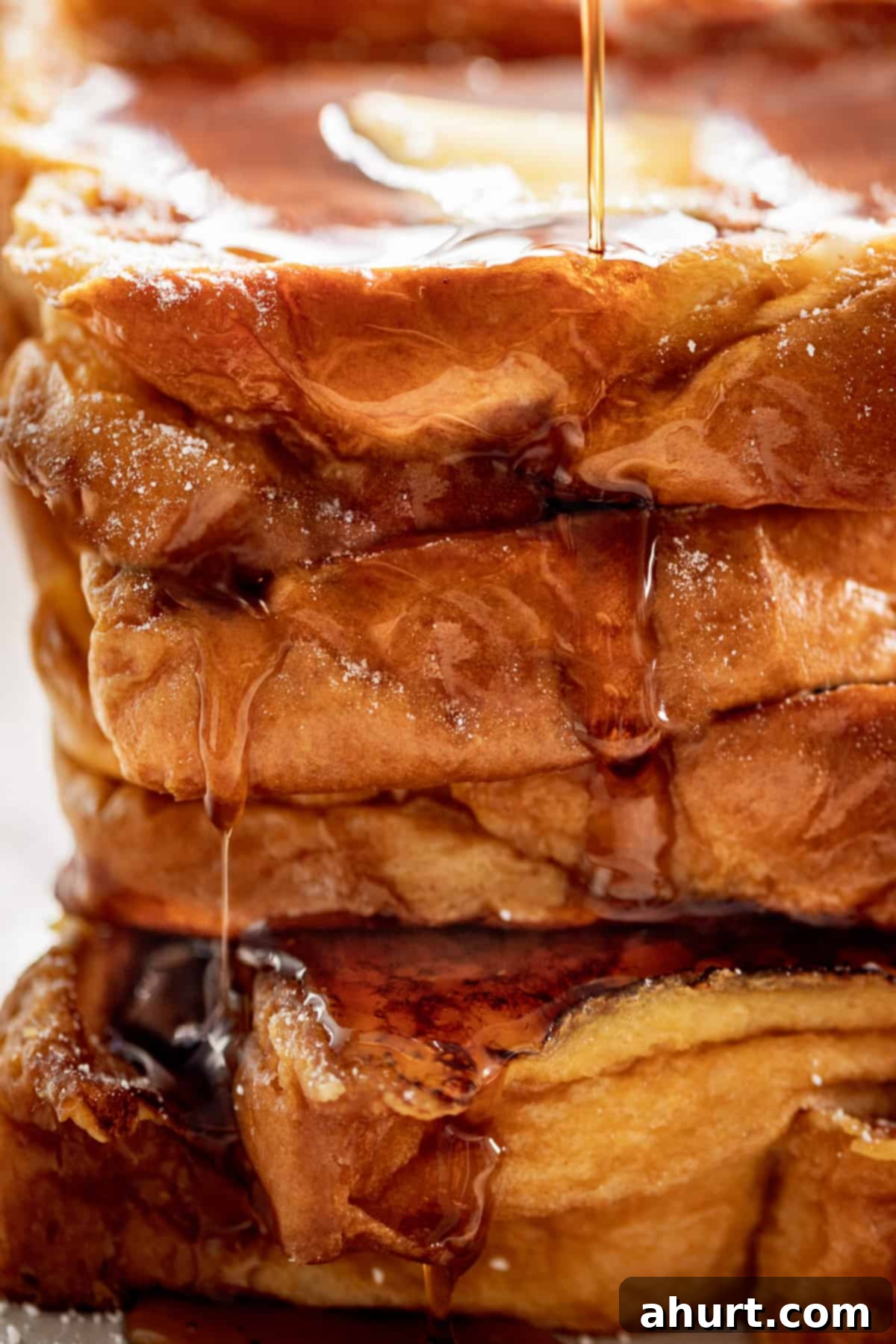The Ultimate Guide to Making the Best Homemade French Toast: Crispy, Fluffy, and Irresistible
There’s something truly magical about a plate of perfectly prepared French Toast. That first bite — the satisfying crunch of a golden, caramelized exterior giving way to a warm, custardy, and incredibly fluffy interior — is pure bliss. We’ve spent countless hours perfecting this recipe to bring you what we confidently call the Best French Toast you’ll ever make. It’s a dish that evokes comfort, warmth, and the simple joy of a leisurely weekend morning, making it a staple for breakfast and brunch enthusiasts alike.
Forget dry, flimsy slices or overly eggy versions. Our easy French toast recipe transforms humble ingredients into a breakfast masterpiece, ideal for a special weekend brunch or a cozy, indulgent treat at home any day of the week. We guide you through selecting the right bread, crafting a perfectly balanced custard, and achieving that sought-after golden-brown crispness that makes every bite unforgettable.
Imagine thick slices of rich, buttery brioche bread, generously soaking up a sweet, aromatic mixture infused with fragrant cinnamon and warm vanilla. Then, these decadent slices are gently pan-fried to a stunning golden perfection, creating a delightful contrast of textures. This isn’t just another French toast recipe; it’s *the* French toast recipe your entire family will absolutely adore, asking for it again and again. Prepare to impress with this effortlessly delicious homemade French toast!
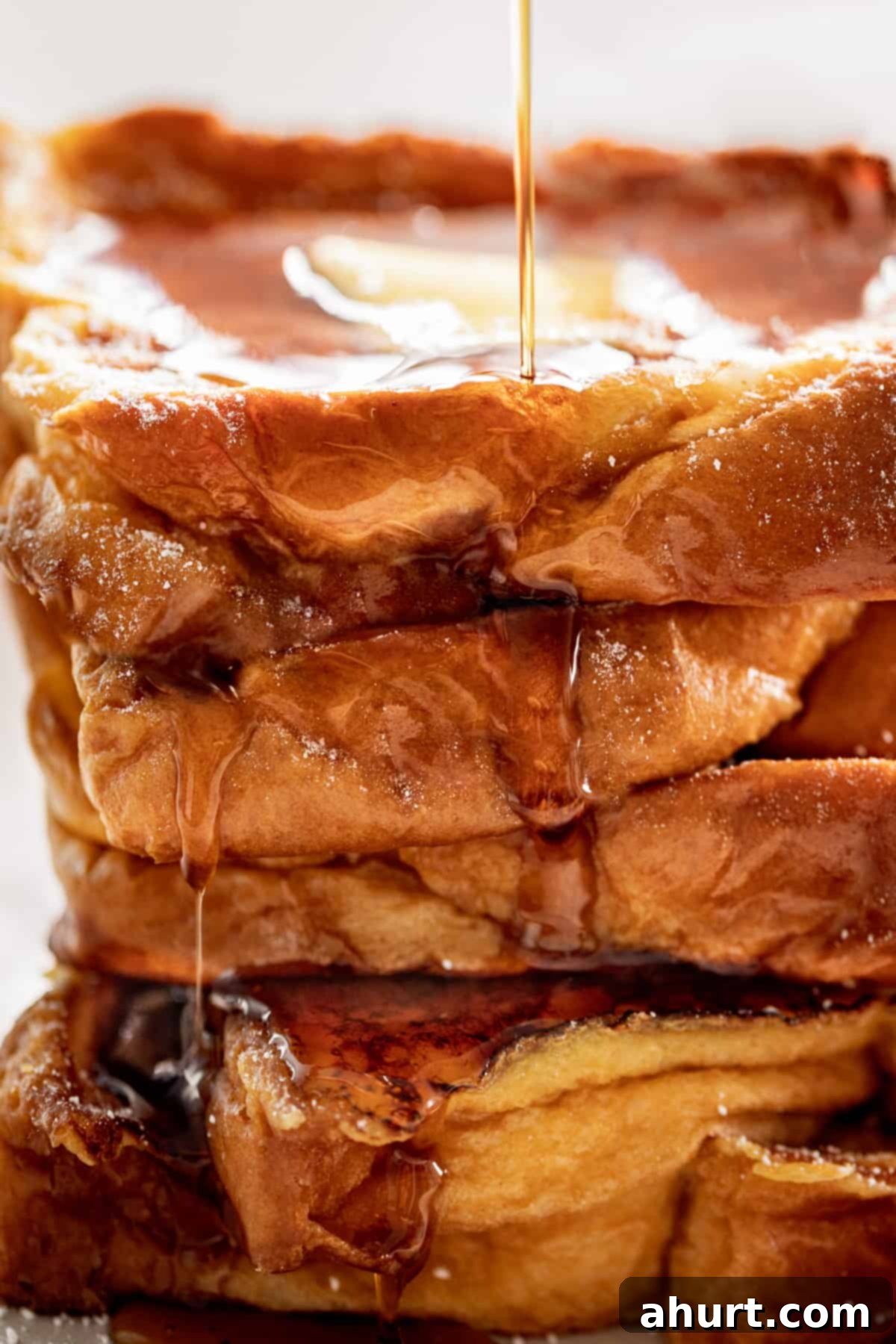
The Secret to Perfect French Toast: Achieving That Golden, Custardy Dream
What sets our French toast apart, making it consistently delicious and reliable? It comes down to a few key elements that work in harmony to deliver that perfect bite every time. Understanding these principles will elevate your homemade French toast from good to truly extraordinary. This simple yet effective method ensures your French toast is always crispy on the outside and perfectly fluffy and custardy on the inside, a texture that makes it stand out.
Choosing the Right Bread: The Foundation of Fluffy French Toast
The choice of bread is paramount. Using thick slices of sturdy, absorbent bread, such as classic brioche or challah, is absolutely crucial. These types of bread possess a rich, buttery crumb that acts like a sponge, allowing them to soak up the luxurious custard mixture without disintegrating. This ensures you get that desired rich, custardy, and fluffy center, perfectly contrasted by delightfully crisp edges. Thin or soft sandwich bread, unfortunately, often becomes soggy and falls apart, leading to a disappointing result. Day-old bread is often preferred as it’s slightly drier and can absorb more liquid without becoming mushy, which is a common trick among seasoned French toast makers.
The Art of the Custard: Flavor and Texture Balance
Our custard mixture is meticulously balanced. It features a harmonious blend of eggs, milk, a touch of sugar, and the warming spices of cinnamon and pure vanilla extract. The sugar not only sweetens but also aids in caramelization, contributing to that beautiful golden-brown crust. The vanilla adds a comforting depth, while cinnamon provides a classic, inviting aroma. The key is to achieve a flavor profile that is warm and cozy without being overly sweet or artificial, allowing the natural goodness of the bread and the eggs to shine through. This delicate balance prevents the toast from tasting overwhelmingly eggy or sugary, creating a truly delightful flavor experience.
The Perfect Pan-Fry: Golden Crust, Soft Interior
The cooking method plays a vital role in achieving the signature texture. Pan-frying your French Toast in a generous amount of butter over medium-low heat is the secret to a beautifully golden, slightly crisp crust. This gentle heat allows the bread to cook through evenly, developing that desirable caramelized exterior while ensuring the interior remains wonderfully soft, custardy, and moist. Rushing the cooking process with high heat often results in burnt outsides and raw, undercooked centers. A non-stick pan is highly recommended for easy flipping and consistent browning, making this easy French toast recipe a foolproof endeavor for anyone, regardless of their cooking skill level.
By focusing on these simple yet essential techniques, you’ll consistently create French toast that boasts a perfect texture and a harmonious blend of flavors, truly making it a special breakfast experience that everyone will crave.
Essential Ingredients for the Best French Toast
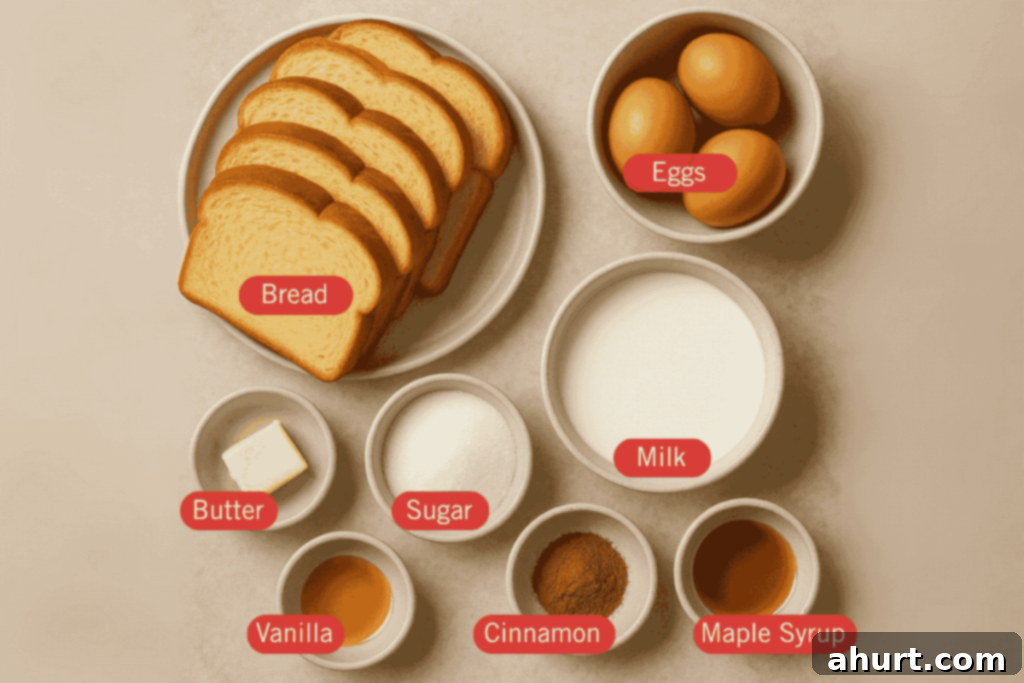
This easy French toast recipe relies on a surprisingly short list of everyday ingredients. The true magic, however, lies in understanding the role each component plays and selecting the right quality to ensure that perfectly rich, custardy, and flavorful bite every single time. Here’s a breakdown of what goes into making the best French toast:
- Brioche Bread: Often considered the gold standard for French toast, its rich, buttery, and slightly sweet nature is incomparable. The thick, sturdy slices are perfectly designed to absorb the custard mixture without becoming soggy, yielding an incredibly tender and moist interior. While brioche is ideal, challah or even a good quality, thick-cut white bread (preferably day-old) can also work wonderfully, providing that essential structural integrity.
- Eggs: The cornerstone of any French toast custard. Eggs are essential for binding the mixture, creating the custardy texture, and adding richness and a beautiful golden color when cooked. For best results, use large, fresh eggs as they contribute significantly to the overall mouthfeel and appearance of your homemade French toast.
- Milk: Adds crucial moisture and contributes to that desirable soft, fluffy texture within the cooked bread. Whole milk is often recommended for its richness, but you can use lower-fat milk, half-and-half, or even heavy cream for an extra decadent touch (though milk is preferred for even browning and lighter results, as discussed in our FAQs).
- Granulated Sugar: A touch of sugar in the custard mixture not only sweetens the French toast but also helps in achieving that beautiful caramelization and golden-brown crust during frying. You can adjust the amount to your preference or even use alternatives like superfine/caster sugar or natural granulated sweeteners.
- Pure Vanilla Extract: This is where much of the classic, comforting aroma and flavor of French toast comes from. A good quality pure vanilla extract adds warmth, depth, and a touch of sweetness that truly elevates the dish, making it smell as good as it tastes. Don’t skimp on this!
- Ground Cinnamon: The quintessential spice for French toast, cinnamon provides a warm, inviting, and slightly sweet undertone that pairs perfectly with the vanilla and bread. A half teaspoon is usually just right to infuse flavor without overpowering, creating a balanced and comforting taste.
- Butter (for griddle): Essential for frying! Cooking French toast in butter not only prevents sticking but also imparts a rich, nutty flavor and helps create that irresistible crisp, golden-brown crust. You can use a mix of butter and a neutral oil for a higher smoke point if preferred, ensuring a perfectly cooked surface every time.
Note: For precise measurements and a comprehensive list of all ingredients, please refer to the detailed recipe card located at the bottom of this article. This will ensure you have everything you need to create this amazing French toast.
Step-by-Step Guide: How to Master the Best French Toast
Creating the best homemade French toast is a straightforward process when you follow these simple steps. Precision in preparation and patience during cooking are your keys to success, ensuring that crispy exterior and delightfully fluffy interior every time. Follow along for perfect results.
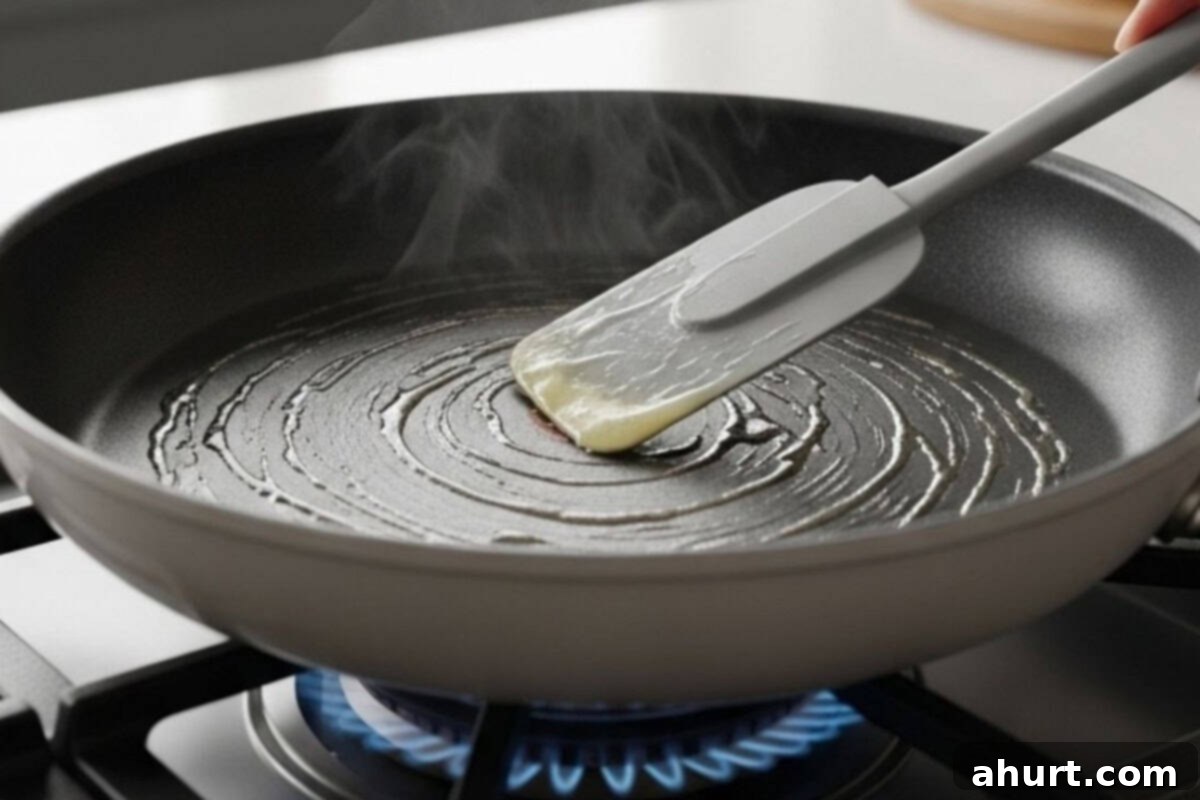
- Preheat and Prepare Your Pan: Begin by placing a large non-stick pan or a griddle over medium-low heat. This allows the pan to heat gradually and evenly, which is crucial for uniform cooking and a perfectly golden crust. Once warm, lightly grease the surface with about half a teaspoon of butter or a neutral cooking oil, spreading it evenly with a spatula. This initial greasing ensures your first batch doesn’t stick and starts browning beautifully without burning.
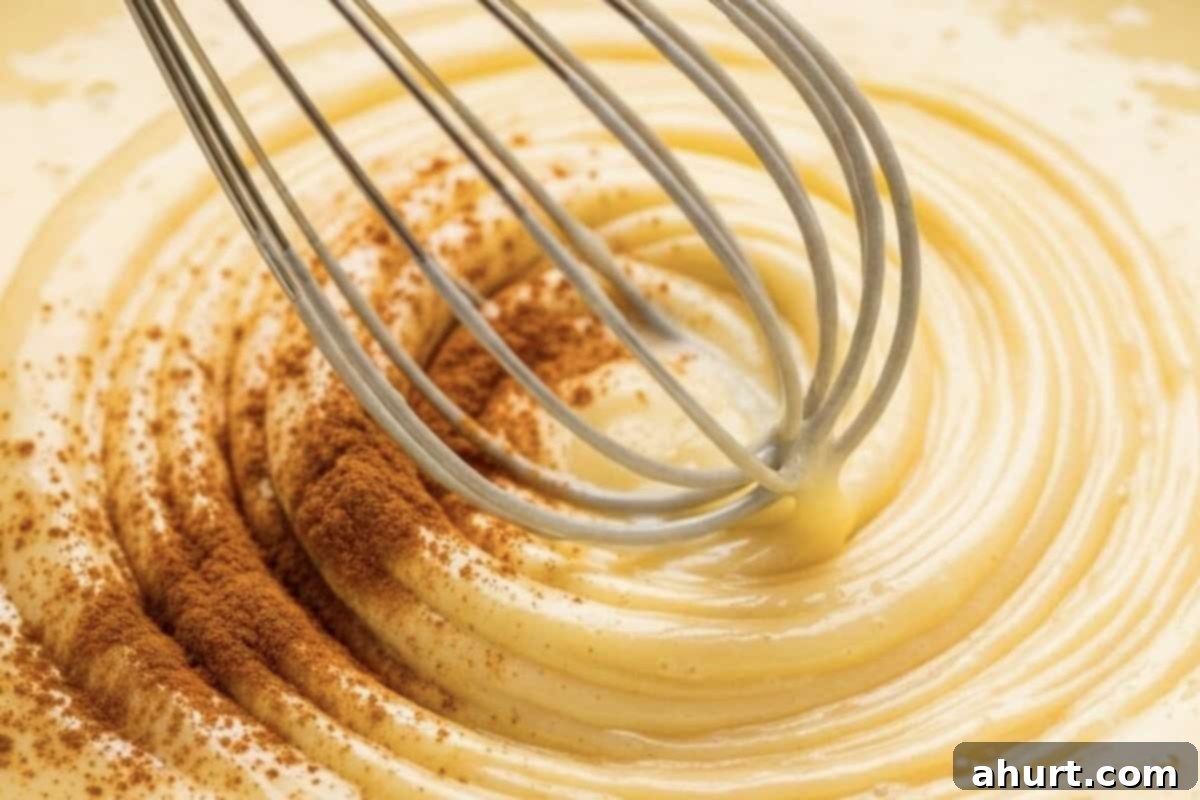
- Craft Your Custard Mixture: In a wide, shallow dish (a pie plate or a large baking dish works perfectly), thoroughly whisk the large eggs until the yolks and whites are fully combined and slightly frothy. This ensures a uniform consistency for your custard. Next, add the milk, granulated sugar, pure vanilla extract, and ground cinnamon. Whisk vigorously again until all the ingredients are fully incorporated and the sugar has dissolved. A shallow dish makes dipping the bread much easier and cleaner, preparing it for the perfect soak.
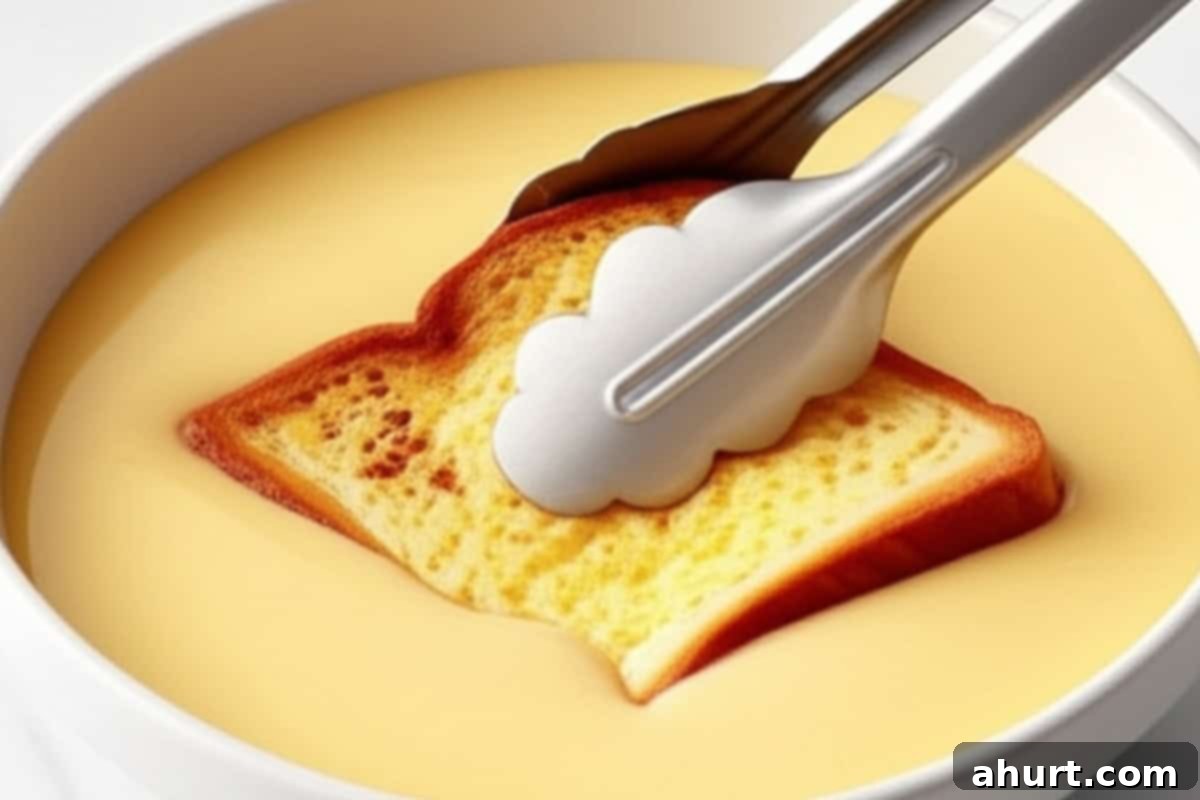
- Properly Soak Your Bread: This step is crucial for achieving that custardy center without sogginess. Working one slice at a time, quickly dip your thick French toast bread into the egg mixture. Allow it to soak for precisely 2 to 3 seconds per side. The goal is for the bread to absorb the flavorful custard without becoming oversaturated and falling apart. If your bread is very fresh, dip for closer to 2 seconds. If it’s slightly stale or very thick, you might go up to 4 seconds, but be cautious not to overdo it, as over-soaking is the number one cause of soggy French toast.
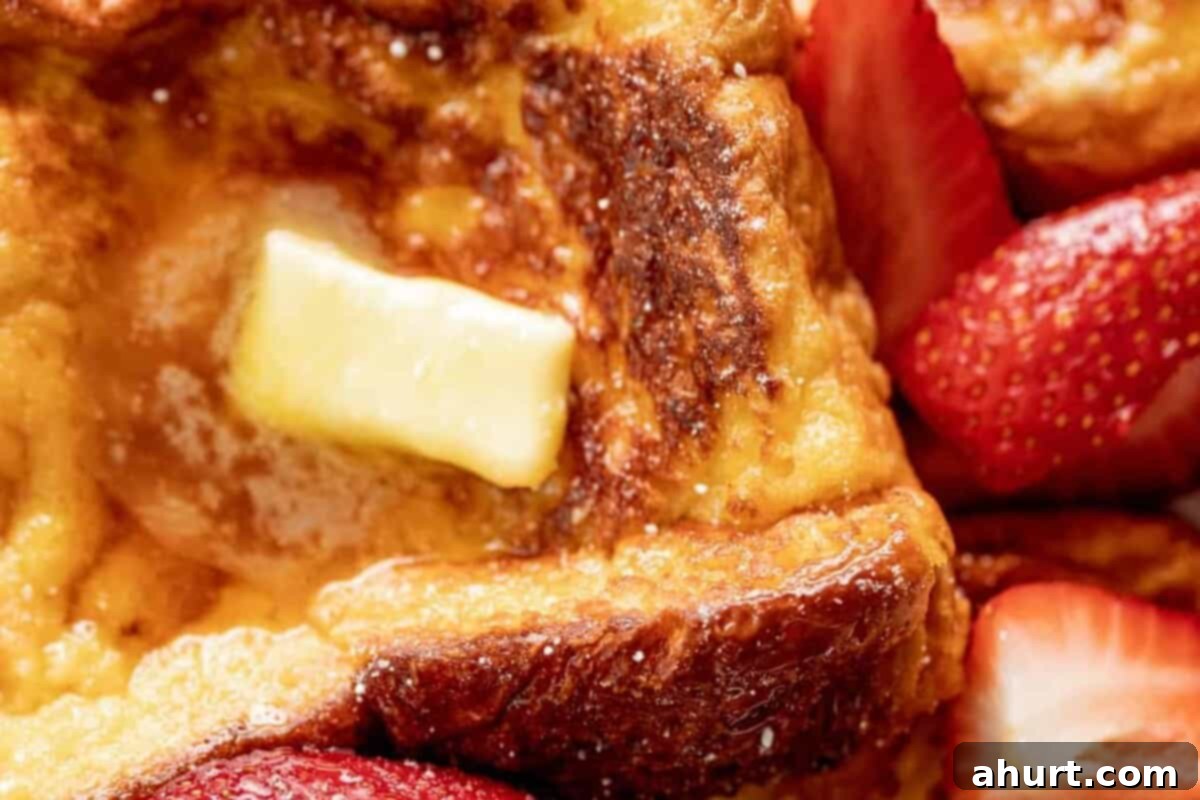
- Cook to Golden Perfection: Carefully transfer the soaked bread slice(s) directly onto the preheated, buttered pan. Fry until the underside achieves a beautiful golden-brown color and a crisp texture, which typically takes about 3 minutes. The edges should appear slightly caramelized. Once golden, gently flip the French toast and cook the other side for another 3-4 minutes, or until it’s equally golden and cooked through. Depending on the size of your pan, you can usually cook 2 slices at a time without overcrowding. Maintain a medium-low heat to ensure even cooking without burning. Repeat this process with all remaining bread slices, adding a tiny bit more butter to the pan between batches if needed, for consistent results.
Serving Suggestions for Your Perfect French Toast
Once your delectable French toast is cooked, the real fun begins: choosing your toppings! While a drizzle of pure maple syrup and a pat of butter are classic for a reason, don’t hesitate to get creative and explore a variety of delicious additions to enhance your breakfast or brunch experience:
- Classic Combos: Alongside pure maple syrup, consider adding fresh berries (strawberries, blueberries, raspberries) for a burst of freshness, a dollop of fluffy whipped cream, or a delicate dusting of powdered sugar.
- Sweet Indulgences: Pair your French Toast with a warm cup of Nutella Hot Chocolate for a cozy, chocolatey complement. A generous spread of your favorite fruit jam, jelly, or a rich drizzle of honey also works wonders for a sweet start to your day.
- Savory Balance: For those who love a sweet and savory breakfast, add a side of perfectly soft and creamy Cream Cheese Scrambled Eggs. Crispy bacon, savory breakfast sausage, or even a slice of grilled ham are also excellent savory additions that beautifully contrast the sweetness.
- Gourmet Twists: For an extra sophisticated treat, serve alongside Cappuccino French Toast with Coffee Cream (if you’re making a variety) — a coffee-infused twist that’s perfect for brunch lovers. Other gourmet ideas include caramelized bananas, a homemade fruit compote (like apple or berry), or a sprinkle of chopped toasted nuts for added texture and flavor.
Troubleshooting Common French Toast Issues
Even with the best recipe, sometimes things don’t go exactly as planned. Don’t worry, homemade French toast is forgiving! Here are some common problems you might encounter and straightforward solutions to ensure your next batch is absolutely flawless.
- Soggy French Toast: This is the most common issue, usually caused by over-soaking the bread or using bread that’s too thin or fresh. The solution: Ensure you’re only dipping each side for 2-3 seconds, especially if using a softer bread like brioche. Using slightly stale, thick-cut bread (day-old is perfect) also helps immensely as it absorbs the custard more efficiently without becoming saturated and mushy.
- Burnt Outside, Raw Inside: This indicates that your pan is too hot. French toast needs to cook gently over medium-low heat to allow the interior to cook through and become custardy before the exterior burns. If the outside is browning too quickly, reduce the heat immediately. Patience is key for that perfect golden crust and fully cooked center.
- Bland or Eggy Flavor: If your French toast lacks flavor, double-check your custard mixture. Ensure you’re using enough vanilla extract and cinnamon – these are crucial for classic French toast taste. Some recipes also benefit from a tiny pinch of salt to balance the sweetness and enhance overall flavor. If it tastes overwhelmingly eggy, you might be using too many eggs relative to the milk, or the eggs weren’t thoroughly whisked into the mixture, leading to uneven distribution.
- Sticking to the Pan: Make sure your non-stick pan is adequately greased with butter or oil before adding each batch. Don’t be shy with a fresh pat of butter for each new slice! If your pan is old or scratched, its non-stick properties may have diminished, and it might be time for a new one or to use a bit more fat.
- Flat or Dense Texture: This can be due to overly dense bread or not enough leavening (though eggs provide some lift). Ensure your bread is thick-cut and has a good, open crumb structure that can puff up when cooked. Also, ensure your custard isn’t too heavy (e.g., if you’re using heavy cream, it can sometimes make the final product denser if over-soaked).
The Rich History of French Toast: More Than Just Breakfast
While often associated with France and affectionately known as “French Toast,” the concept of soaking bread in an egg and milk mixture and frying it dates back much further than the name suggests. In France, this beloved dish is known as “pain perdu,” which translates to “lost bread.” This name perfectly captures its original purpose: a clever and resourceful way to utilize stale or day-old bread, preventing waste by transforming it into a delicious, comforting, and hearty meal. This culinary ingenuity has ancient roots.
Indeed, some of the earliest recorded recipes resembling French toast can be traced back to ancient Rome. A 4th-century A.D. Roman cookbook called “Apicius” describes a dish referred to as “Pan Dulcis” (sweet bread), where bread was soaked in milk and egg, then fried in oil or butter and drizzled with honey. This demonstrates that the basic principle of enriching stale bread for consumption has been around for millennia.
Throughout the Middle Ages in Europe, variations of this dish were common, often known by names like “poor knight’s pudding” in England or “German toast” (Arme Ritter in Germany), further highlighting its economical and practical origins across different cultures. It was a staple for making the most of available ingredients, particularly when fresh bread was scarce. The French toast we know and love today evolved over centuries, embracing richer ingredients like brioche and additional flavorings like vanilla and cinnamon, transforming a humble necessity into a gourmet delight. It truly embodies the spirit of culinary resourcefulness, turning something ordinary into something extraordinary. This simple yet elegant dish has endured through time, becoming a beloved breakfast and brunch staple worldwide, cherished for its versatility, satisfying qualities, and delightful taste.
French Toast Recipe FAQs
While you certainly can use heavy cream or half and half in your French toast custard for an extra rich and decadent result, regular milk (especially whole milk) is generally preferred for this specific recipe. Milk is lighter, which helps the bread brown more evenly without becoming overly saturated or heavy. Using cream can sometimes lead to soggy centers or a tendency for the edges to overcook before the interior is fully set. If you opt for cream, you might want to slightly reduce the soaking time to prevent the toast from becoming too dense, and ensure your pan heat is kept low and consistent.
Absolutely! You have several options for sweetening your French toast custard, depending on your dietary preferences. White granulated sugar is a classic choice, but you can also use raw sugar, light brown sugar (which adds a lovely molasses note and aids in caramelization), or even natural granulated sweeteners like Swerve or Natvia if you’re looking for a low-sugar or keto-friendly alternative. Just be sure to avoid liquid sweeteners like maple syrup or honey directly in the custard, as they can alter the consistency and prevent proper browning. If using a granulated alternative, always follow the packet instructions for equivalence to regular sugar measurements to ensure the perfect sweetness level for your homemade French toast.
For truly exceptional French toast, the bread choice is paramount. We highly recommend using sturdy, thick-cut breads that can absorb the custard without falling apart. Brioche is often considered the ultimate choice due to its rich, buttery, and slightly sweet flavor profile, and its ability to create an incredibly tender interior. Challah, a similarly rich and eggy bread, is another fantastic option. Thick-cut white bread can also work well, especially if it’s a day or two old, as slightly stale bread absorbs liquid better without becoming mushy. Avoid thin, soft sandwich bread as it tends to get soggy and doesn’t hold up well. Ultimately, a bread that is at least 3/4 to 1 inch thick and has a good, robust crumb structure will yield the best, custardy, and fluffy results that everyone will love.
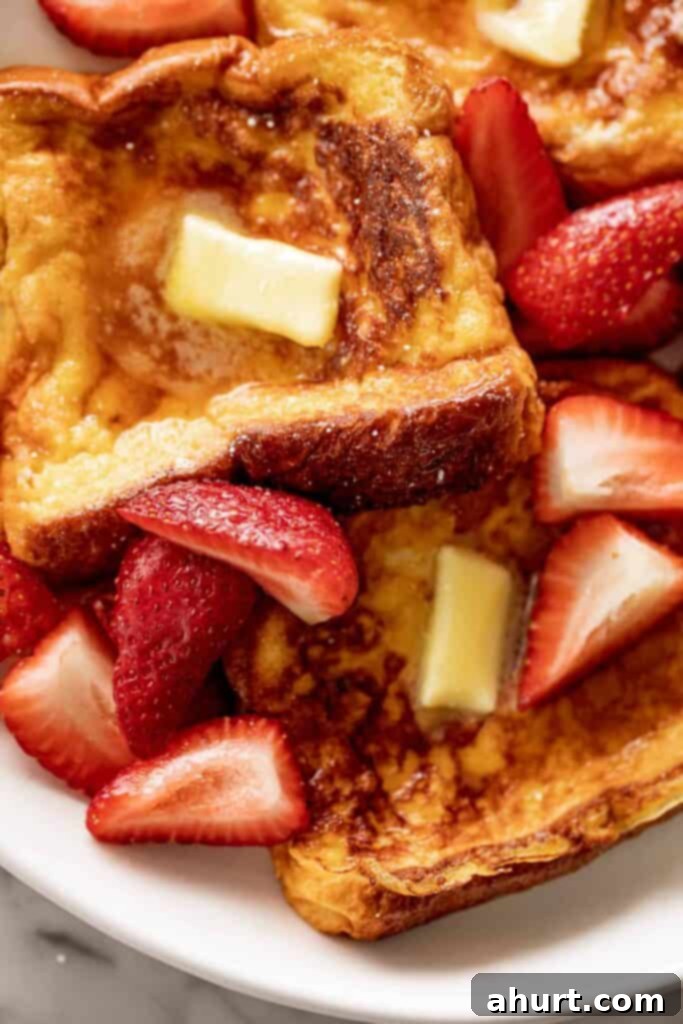
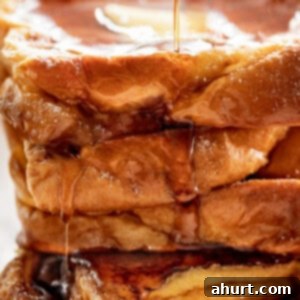
Pin
French Toast
Ingredients
- 8 slices brioche bread sub with any bread if desired
- 3 large eggs
- 3/4 cup milk
- 1 tablespoon granulated sugar or superfine/caster sugar
- 1 1/2 teaspoons pure vanilla extract
- 1/2 teaspoon ground cinnamon
- 1/2 teaspoon butter for griddle
- 1/2 tablespoon jam jelly, butter, maple syrup or honey, to serve
Instructions
-
Preheat a non-stick pan or skillet over medium-low heat.
-
Whisk eggs in a large, shallow dish. Add the milk, sugar, vanilla and cinnamon; whisk well to combine.
-
Lightly grease pan with a little butter or cooking oil, spreading evenly over the surface with a spatula.
-
Working quickly, dip one slice of bread into the egg wash, allow to soak for 2-3 seconds; flip and dip the other side, soaking again for a further 2-3 seconds.
-
Fry until golden browned on underside, (about 3 minutes), then flip and cook until golden browned, (about another 3-4 minutes). You can cook 2 toasts at a time, depending on the size of your pan.
-
Repeat with remaining bread slices.
-
Serve warm with desired toppings.
Notes
- Bread Choice: While brioche is ideal, any sturdy, thick-cut bread (like challah or even day-old white bread) will yield delicious results. Avoid thin, soft sandwich bread which tends to get soggy.
- Milk Preference: Using regular whole milk (instead of heavy cream) is recommended for French toast that browns more evenly and remains perfectly fluffy without becoming too dense or soggy.
- Don’t Over-Soak: A quick 2-3 second dip per side is usually enough for thick bread. Over-soaking leads to soggy, difficult-to-handle French toast with an unpleasant texture.
- Medium-Low Heat is Key: Patience with lower heat ensures a perfectly golden, crispy exterior and a fully cooked, custardy interior. High heat will burn the outside before the inside cooks through.
- Serve Immediately: French toast is always best enjoyed fresh off the pan with your favorite toppings! If making a large batch, you can keep cooked slices warm in a single layer on a baking sheet in a low oven (around 200°F/95°C).
Nutrition
Nutrition information is automatically calculated, so should only be used as an approximation.
